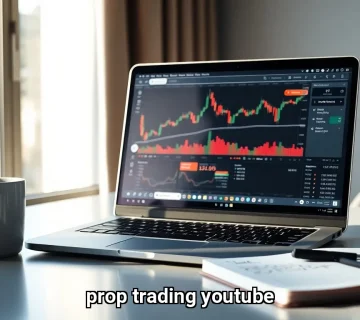In the fast-paced world of financial markets, staying informed about prop trading developments is crucial for traders, firms, and investors alike. Prop trading news offers a window into the latest shifts shaping proprietary trading firms—from regulatory changes and technological breakthroughs to innovative strategies and risk management advancements. Whether you’re looking to understand how new SEC proposals might alter compliance requirements or eager to explore how artificial intelligence is revolutionizing trading algorithms, timely updates provide essential insights.
As prop trading firms expand into multi-asset markets and embrace cutting-edge cloud-based platforms, keeping up with these trends can make the difference between seizing profitable opportunities and falling behind. This evolving landscape also highlights the growing importance of collaboration between technology providers and trading desks, as well as the rise of educational initiatives that empower traders to navigate complex environments.
By following current prop trading news, market participants can anticipate shifts in regulation, technology, and strategy—ensuring they remain competitive and compliant in an industry defined by rapid innovation. Dive into the latest updates to discover how proprietary trading is adapting to today’s challenges and shaping the future of financial markets.
Regulatory Changes Impacting Prop Trading Firms
Recent prop trading news has highlighted significant regulatory developments affecting proprietary trading firms, particularly those engaged in algorithmic trading. The U.S. Securities and Exchange Commission (SEC) proposed amendments that could narrow exemptions allowing many prop trading broker-dealers to operate without membership in the Financial Industry Regulatory Authority (FINRA). If adopted, these rules will require non-FINRA-member proprietary trading firms trading on dark pools or alternative trading systems to register with FINRA. This shift introduces new compliance obligations and associated costs for firms that were previously exempt.
FINRA’s move to seek comments on requiring registration of the principal developers and supervisors of algorithmic trading strategies marks another critical regulatory pivot. Regulatory Notice No. 15-06, issued in 2015, proposed that associated persons involved in designing or modifying algorithmic trading strategies be registered. This does not extend to all technology personnel but targets those with significant influence on trading algorithms. The goal is to increase oversight and accountability in an environment where algorithmic trading strategies significantly impact market dynamics.
These regulatory initiatives reflect growing concerns over the risks and systemic impact of proprietary trading firms operating with minimal oversight. Firms must now navigate evolving compliance landscapes while maintaining competitiveness, which prop trading news consistently reports as a major challenge.

Technological Advancements Driving Prop Trading Strategies
Recent prop trading news highlights technology’s role in transforming prop trading strategies. Firms leverage AI, machine learning, and cloud computing to analyze vast datasets and detect market inefficiencies. AI-driven systems enhance trade execution speed and precision, optimizing profitability in prop trading. Cloud-based platforms, like MetaTrader 5 (MT5) used by Propx Pro, provide real-time data and backtesting for forex, crypto, and stocks.
Propx Pro’s model offers funded accounts (8-10% profit targets, 5-10% drawdown) and 24/7 Discord support, aligning with prop trading news trends by enabling traders to focus on strategy execution with minimal latency.
Diversification and Multi-Asset Trading in Prop Firms
One of the most notable trends in prop trading news is the increasing emphasis on offering access to multiple asset classes within a single platform. Proprietary trading firms now frequently provide opportunities across foreign exchange (FX), contracts for difference (CFDs), futures, and cryptocurrencies. This multi-asset approach allows traders to diversify portfolios, hedge risks, and capitalize on varied market conditions.
Diversification reduces dependence on the volatility or liquidity of any single market. For example, when futures markets experience low volatility, crypto markets might exhibit higher activity, providing alternative profit avenues. Firms that enable seamless access across these asset classes give their traders flexibility and improved risk-adjusted returns.
Multiple platform options also enhance trader experience, allowing individuals to select interfaces and tools that best suit their trading style. Some traders prefer algorithmic-friendly platforms with extensive APIs, while others may gravitate towards user-friendly graphical interfaces optimized for manual trading. Prop firms adopting this inclusive approach can attract a wider talent pool, a trend extensively covered in recent prop trading news.
Risk Management Innovations in Proprietary Trading
Effective risk management remains a cornerstone of successful proprietary trading. Recent prop trading news emphasizes how firms integrate technology to monitor and mitigate risks in real time. Advanced risk analytics utilize AI to assess market exposure dynamically, flagging anomalies or potential breaches of risk limits before losses escalate.
Propx Pro’s model of providing capital to traders while absorbing certain risks exemplifies innovative risk-sharing frameworks. By underwriting trader accounts, Propx Pro mitigates financial risk for individual traders, enabling them to operate with greater confidence and focus on strategy refinement. This approach aligns with evolving prop trading industry standards that prioritize capital preservation alongside profit generation.
Moreover, algorithmic surveillance tools monitor order flow and trading behavior for compliance with regulatory and internal risk policies. This reduces the likelihood of disruptive trading practices, such as excessive leverage or unauthorized strategy deployment. Firms investing in such integrated risk controls enhance their reputation and operational resilience, a frequent highlight in prop trading news reports.

Emerging Prop Trading Strategies and Market Adaptation
The landscape of prop trading strategies continues to evolve rapidly, driven by technological progress and changing market environments. Proprietary trading firms now deploy a variety of sophisticated techniques, including market making, statistical arbitrage, and high-frequency trading.
Market making involves providing liquidity by continuously quoting bid and ask prices, profiting from the bid-ask spread. This strategy requires robust infrastructure and precise risk controls to manage inventory and price volatility. Recent prop trading news indicates that market makers increasingly use AI-driven algorithms to optimize quoting strategies and adapt to fluctuating market conditions.
Statistical arbitrage employs quantitative models to identify pricing inefficiencies between related securities. By executing paired trades, firms can lock in profits with minimal directional market risk. This strategy benefits from access to extensive historical and real-time data, which is now more readily available thanks to cloud computing platforms.
High-frequency trading (HFT) remains a significant strategy in the prop trading space. HFT firms utilize ultra-low latency connections and co-location services to execute thousands of trades per second, capitalizing on micro-movements in price. Technological arms races in hardware and software development continue to shape this arena, with firms investing heavily to maintain competitive advantages.
Industry Collaboration and Education in Prop Trading
Recent prop trading news also underscores the importance of education and collaboration within the industry. As strategies grow more complex, firms emphasize continuous learning and knowledge sharing to maintain an edge. Organizations and platforms provide workshops, webinars, and mentorship programs designed to enhance trader skills in quantitative methods, risk management, and regulatory compliance.
Propx Pro facilitates such initiatives by equipping its licensees with tools and resources needed to scale their prop firms successfully. Their CRM and branded dashboards not only streamline administrative tasks but also foster communication between management and traders. This supports a culture of transparency and ongoing development, essential for adapting to the rapidly shifting landscape highlighted in prop trading news.
Partnerships Between Technology Providers and Prop Firms
Another noteworthy trend is the growing collaboration between technology providers and proprietary trading firms. These partnerships enable prop firms to access cutting-edge software solutions, data feeds, and execution venues without building everything in-house. This synergy accelerates innovation and reduces operational costs.
For example, cloud infrastructure providers offer scalable computing resources tailored to the needs of prop trading firms. Data vendors supply high-frequency market data and alternative data sets, such as satellite imagery or consumer behavior metrics, which traders integrate into their models.
By engaging with specialized technology partners, prop trading firms can focus on refining strategies and managing risk, leaving infrastructure and data acquisition to experts. This collaborative model is frequently cited in recent prop trading news as a key driver of industry growth.

Future Outlook: Prop Trading News Trends to Watch
Prop trading news points to evolving trends shaping prop trading. Regulatory bodies, like the SEC and FINRA, are refining algorithmic trading rules to enhance transparency. AI and big data will deepen strategy sophistication, while ESG factors may influence prop trading approaches.
Firms like Propx Pro, with MT5 platforms, Instant Funding, and 80-90% profit splits, democratize access to capital, expanding the talent pool. Prop trading news also predicts growth in hybrid strategies for crypto and traditional assets, requiring firms to navigate diverse regulations and volatility for sustained prop trading success.
Embracing the Future of Proprietary Trading: Insights and Opportunities
As proprietary trading continues to evolve at a remarkable pace, staying attuned to the latest developments in regulation, technology, strategy, and collaboration is indispensable for success. The dynamic interplay between advancing AI-driven techniques, expanding multi-asset platforms, and heightened regulatory scrutiny demands that traders and firms remain adaptable and informed.
Innovations in risk management and strategic diversification not only enhance resilience but also unlock new avenues for profit in increasingly complex markets. Furthermore, the growing synergy between technology providers and proprietary trading firms fosters an environment ripe for continuous improvement and competitive advantage.
By actively engaging with emerging trends and educational initiatives, market participants can confidently navigate challenges and harness opportunities that define the future of prop trading. Ultimately, keeping a finger on the pulse of proprietary trading news empowers stakeholders to thrive in an industry where agility and insight are the keys to sustained growth and innovation.




No comment